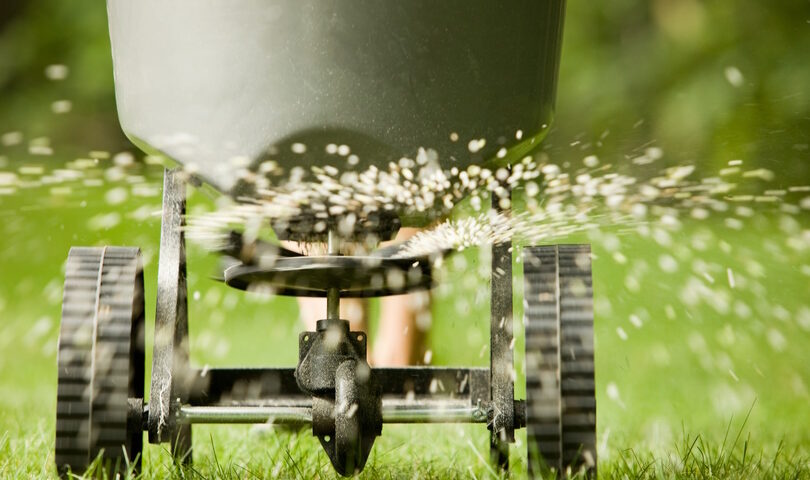What lawn fertilizer is safe for well water? If your property contains a well, you know that you need to take certain steps to preserve your water quality. That includes paying attention to the lawn fertilizer you use near any wellsite. You’ll want to test your water once a year or so to confirm that it’s clean and safe. But how should you treat your lawn in the meantime? What lawn fertilizer is safe for well water?
So, What Lawn Fertilizer Is Safe For Well Water? What Lawn Fertilizers Should I Avoid If I Have A Well?
For starters, you’ll want to avoid chemical fertilizers and stick with organic ones. Organic fertilizers work in conjunction with the organisms already present in your soil to release nitrates slowly and steadily, helping ensure that your grass absorbs nitrates and other nutrients before they reach your well.
More specifically, you’ll want to look for a granular or liquid-feed fertilizer. Granular fertilizers offer the slowest release of nitrates, allowing for fewer applications throughout the year. If granular fertilizers are not readily available in your area, liquid-feed options can be nearly as convenient and just as safe.
Let’s look at the top organic fertilizers on the market for those of us concerned with the quality of our well water.
The Best Organic Fertilizers for Use Near Wells
Safer Lawn Restore
The same slow release that makes organic fertilizers so safe can also be a source of frustration for property owners who want to see quick results. Safer brand’s Lawn Restore product addresses this problem by penetrating directly down to the root level, where it is much more easily absorbed and used than traditional top-growth fertilizers. Homeowners typically see results, including increased hardiness and enhanced color, within a few days of application. There is one significant, if temporary, drawback: Safer’s latest formulation is reportedly more difficult to apply and leaves a sharp odor for some time after application.
The Andersons 7-1-2 Innova Organic Fertilizer
Innova’s 7-1-2 NPK formula includes amino acids in an all-natural and highly efficient fertilizer. Aside from a binding agent, Innova granules are composed of active ingredients: they contain no composed waste, biosolids, or animal byproducts. This may also account for Innova’s firm composition. Very little of the product is lost to dust, which improves coverage while saving homeowners from irritation of the eyes and throat. A 40-pound bag covers up to 5,600 square feet, and Innova is especially forgiving of accidental overapplication, even near wellsites.
Scotts Natural Lawn Food
One of the most widely available organic lawn fertilizers, Scotts Natural Lawn Food has earned a reputation for versatility, easy application, and solid performance on a wide range of grass varieties. This all-season formula is appropriate before or after seeding or sodding, before overseeding, and throughout the growing season. It may be a bit too friendly, in fact, for some members of the family: Scotts Natural is nontoxic for children and pets, but many dogs mistake the pellets for treats (with predictable, sometimes messy, results for anyone whose dog likes to eat things it shouldn’t). Not to sound the alarm: aside from a possible bit of extra cleanup, Scotts Natural is safe for dogs to eat.
Jonathan Green Organic Lawn Food
Unlike some fertilizers on this list, Jonathan Green’s entry makes heavy use of animal proteins, including feather meal. Most of its ingredients, though, are plant-based: soybean meal, wheat middlings, and even molasses. This is a nitrogen-heavy fertilizer with a 10-0-1 NPK ratio along with plenty of iron for greener grass. It is also entirely safe for children and pets, and highly efficient: a 17-pound bag covers up to 5,000 square feet of lawn.
Milorganite Organic Nitrogen Fertilizer
Milorganite is the grandfather of branded organic fertilizer, with a history stretching back more than a century. Its secret is the nutrient-heavy microbes used to treat wastewater. When the City of Milwaukee searched for a better way to dispose of these microbes, which form a heavy sludge after they digest organic matter in the city’s water, they hit upon the idea of heat-drying them and creating a potent, portable fertilizer. The result is an entirely organic 6-4-0 fertilizer with a heavy iron component of 2.5%. While Milorganite is not the most efficient fertilizer available—a 36-pound bag feeds just 2,500 square feet—it is among the safest and most proven, in terms of both its performance and its ability to protect nearby well water.
Summing Up
If your lawn runs right up to a well, you can still keep it well-nourished and green. Just be sure to use an organic fertilizer whose NPK ratio matches the needs of your soil and the varieties of grass you’ll be feeding.

